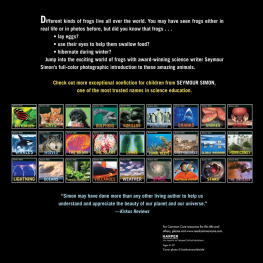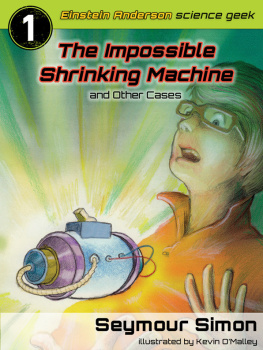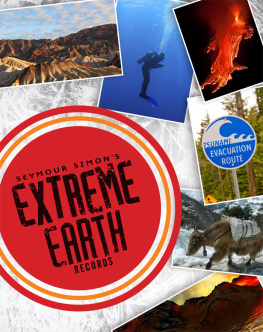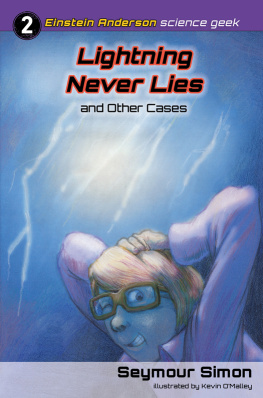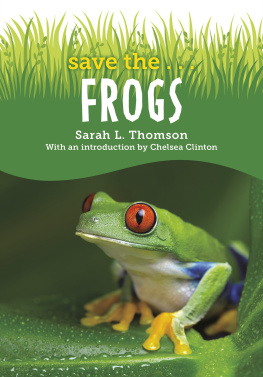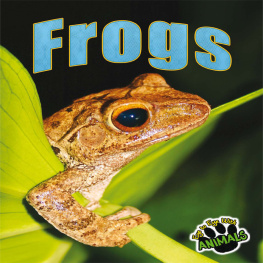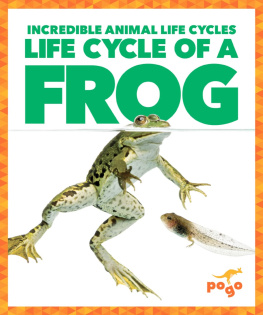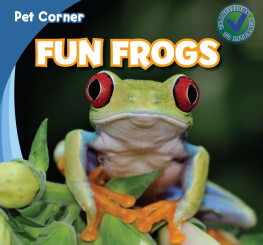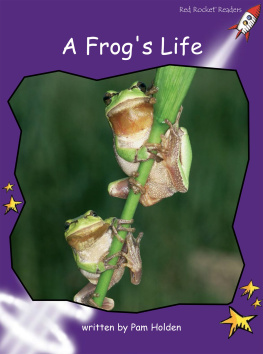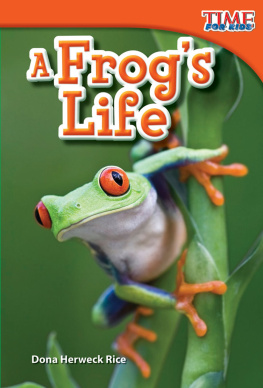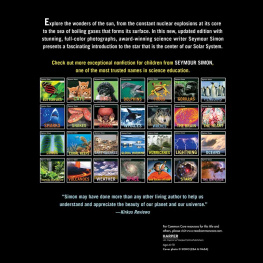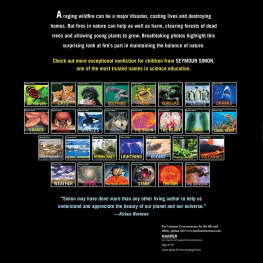


This book is dedicated to the special bonding that takes
place between kids and their caregivers who explore
together the wonders of frogs in the spring.
PHOTO CREDITS: Page 2: Naturfoto Honal/Corbis; page 4: Eric Isselee; page 6: Brian Lasenby; page 7: Animals Animals/SuperStock;page 8: Valerii Kirsanov; page 9: Galyna Andrushko; page 10: Hunsa Prachansuwan; page 11: Heidi & Hans-Juergen Koch/MindenPictures/Corbis; page 12: Carmina Mcconnell; page 14: tonarinokeroro; page 15: Nature PL/SuperStock; page 17: hotshotsworldwide;page 18: imagebroker.net/SuperStock; page 19: Cathy Keifer; page 20: Chris Hill; page 21: Flirt/SuperStock; page 22: Stephen Dalton;page 23: Oleg Tovkach; pages 2425: NHPA/SuperStock; pages 2627: Benoit Daoust; page 28: Marie Daloia; page 30, top to bottom: Cathy Keifer; Brian Lasenby; page 31: donyanedomam; pages 3233: Minden Pictures/SuperStock; page 34, top to bottom: Mrs. Ya; age footstock/SuperStock; page 35: hotshotsworldwide; page 36: STR/Reuters/Corbis; pages 3839: hotshotsworldwide.
FROGS. Copyright 2015 by Seymour Simon. All rights reserved under International and Pan-American Copyright Conventions. By paymentof the required fees, you have been granted the non-exclusive, non-transferable right to access and read the text of this e-book on screen.No part of this text may be reproduced, transmitted, downloaded, decompiled, reverse engineered, or stored in or introduced into anyinformation storage and retrieval system, in any form or by any means, whether electronic or mechanical, now known or hereinafter invented,without the express written permission of HarperCollins Publishers.
Library of Congress Cataloging-in-Publication Data is available.
EPub Edition 2015
ISBN: 9780062289131
10 9 8 7 6 5 4 3 2 1
First Edition
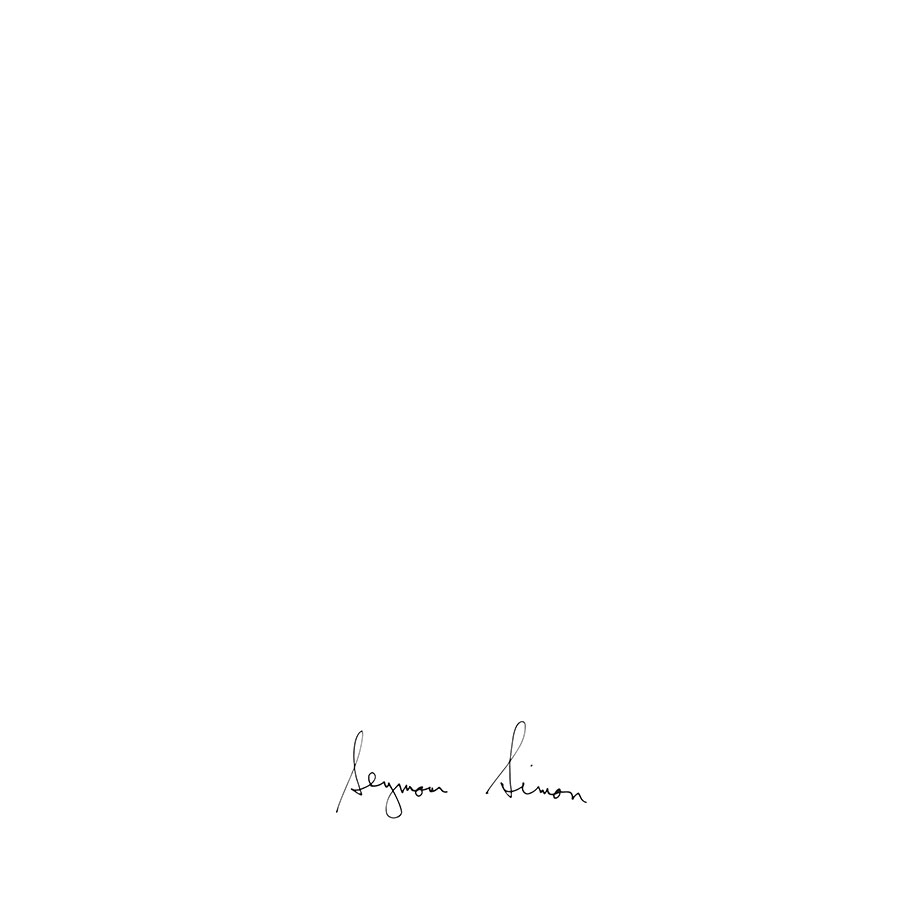
Author's Note
From a young age, I was interested in animals, space, my surroundingsall thenatural sciences. When I was a teenager, I became the president of a nationwidejunior astronomy club with a thousand members. After college, I became aclassroom teacher for nearly twenty-five years while also writing articles andbooks for children on science and nature even before I became a full-time writer.My experience as a teacher gives me the ability to understand how to reach myyoung readers and get them interested in the world around us.
Ive written more than 250 books, and Ive thought a lot about different waysto encourage interest in the natural world, as well as how to show the joys ofnonfiction. When I write, I use comparisons to help explain unfamiliar ideas,complex concepts, and impossibly large numbers. I try to engage your sensesand imagination to set the scene and to make science fun. For example, inPenguins, I emphasize the playful nature of these creatures on the very first pageby mentioning how penguins excel at swimming and diving. I use strong verbs toenhance understanding. I make use of descriptive detail and ask questions thatanticipate what you may be thinking (sometimes right at the start of the book).
Many of my books are photo-essays, which use extraordinary photographs toamplify and expand the text, creating different and engaging ways of exploringnonfiction. Youll also find a glossary, an index, and website and researchrecommendations in most of my books, which make them ideal for enhancingyour reading and learning experience. As William Blake wrote in his poem, Iwant my readers to see a world in a grain of sand, / And a heaven in a wildflower, / Hold infinity in the palm of your hand, / And eternity in an hour.


F rogs are amphibians , animals that live in water and on land. Even when living on land, frogs dont drink water. Instead, they soak water into their bodies through their moist skins. Frogs look like frogs only part of their lives. For the first part of their lives, they dont have arms or legs and they look more like fish. Newborn frogs, called tadpoles , live underwater and even have gills like fish. But something strange and wonderful happens as they become adults. They lose their gills, grow arms and legs, and come on land as frogs.

E arly spring is the best time to look for frogs in temperate regions. In the central and eastern parts of the United States and Canada, the sound of frogs is the signal that spring is coming. Just after the snow melts, you can hear the sounds of frogs called spring peepers. Spring peepers are small frogs that are less than an inch and a half in length.

Peepers wake up from their winter sleep and begin to peep loudly from early March to May or June. They have sacs under their mouths that inflate like little balloons. When the air is released from the sac, it makes a sound like a high- pitched whistle, but a chorus of peeps is like an orchestra of jingling bells. The chorus is the sound of hundreds of male spring peepers calling for mates. If you go close to a pond full of peepers, they fall silent and theyre hard to see. Spring peepers begin to sing at sundown because they are most active at night.


F rogs are exothermic , or cold- blooded, which means that their body temperature changes with their surroundings. They are cold when the water or air around them is cold, and they are warm when the water or air around them is warm.
Just like their ancestors, frogs are adaptable to different conditions and have been on Earth for over million years. Scientists know this because they have found frog fossils that date back to the Jurassic period, when dinosaurs roamed the land.

D ifferent kinds of frogs live all over the world and on every continent except ice- covered Antarctica. They usually live near slow- moving bodies of water, or wetlands , such as lakes, ponds, and marshes. But some kinds of frogs live in fast- moving waters, such as waterfalls, while other kinds live in dry deserts. In deserts, frogs burrow into the ground and stay in a kind of sleep, called estivation , until it rains. Frogs do not live in the oceans or other bodies of salt water.

